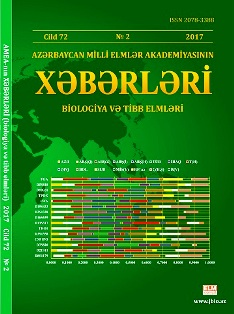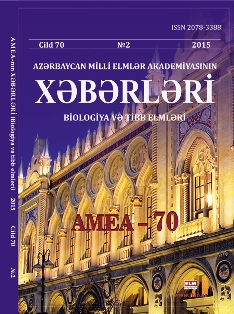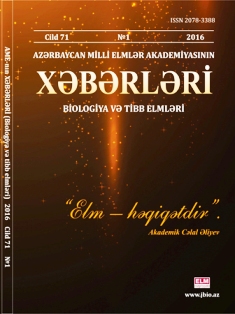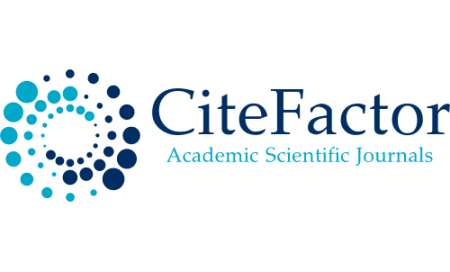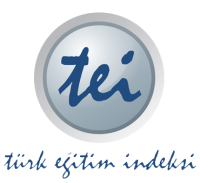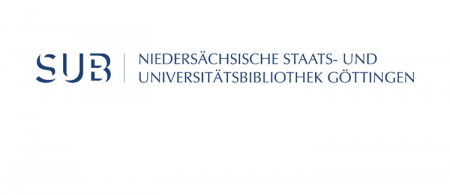
The effects of heavy metals on biochemical processes in the human body (review)
Research article: The effects of heavy metals on biochemical processes in the human body (review)
Author: R.I. Ibrahimov
Azerbaijan Medical University, 23 Bakikhanov Str., Baku AZ 1022, Azerbaijan For correspondence: iri-71@mail.ru
Accepted for publication: 05 June 2020
Abstract: Environment and human health are closely related. Heavy metals are priority pollutants, as they are highly toxic to living organisms in relatively low concentrations. The World Health Organizati- on considers them to be the most dangerous xenobiotics for human health. The paper reviews rese- arch on the toxic effects of heavy metals on biochemical processes in the human body and the clini- cal analysis of diseases caused by them. The author has presented the various mechanisms of heavy metal toxicity at the molecular level and shown the role of oxidative stress in the pathogenesis of di- seases of the cardiovascular, nervous and respiratory systems, associated with the action of heavy metals, on a sufficiently large material. The analysis of literature data demonstrates the significant role and necessity of further study of biochemical mechanisms of the development of pathological processes under chronic exposure to various toxic heavy metals in order to develop effective met- hods of chronic diseases treatment.
Keywords: Heavy metals, bioaccumulation, toxicity, biochemical disorders, complexing ability, oxidative stress
References
Bagandova L. M., Astarkhanova T. S., Ashurbekova T. N. (2011) Bioecological monitoring of anthropogenic impacts in different types of economic activity. South of Russia: ecology, development, 6 (3): 99-101.
Balabekova M.K., Ryspekova N.N., Zhukesheva M.K. et al. (2015) Dynamics of the course of inflammation caused by metal-induced immunosuppression. Zh. Modern problems of science and education, 6: 276 p.
Batyan A. N., Frumin G. T., Bazylev V. N. (2009) Fundamentals of general and ecological toxicology. St. Petersburg: SpetsLit., 352 p.
Mount E.P. (2007) Human ecology. Tutorial. M., 540 p.
Duskaev G. K., Miroshnikov S. A., Sizova E. A. et al. (2014) Influence of heavy metals on the organism of animals and the environment (review). Bulletin of beef cattle breeding, 3: 7-11.
Kutsenko S.A. (2004) Fundamentals of toxicology. Moscow: Folio, 570 p.
Lysenko N. N., Dogadina M. A. (2015) Fundamentals of ecotoxicology: textbook. allowance. Orel GAU, 460 p.
Wise I.V. (2008) Impact of chemical soil pollution on public health. Hygiene and Sanitation, 4:32-37.
Oberlis D., Harland B., Skalny A. (2008) The biological role of macro- and microelements in humans and animals. St. Petersburg: Nauka, 544 p.
Polina I. N. (2012) Toxicology: a textbook. Syktyvkar: SLI, 2012: 128 p.
Revich B.A. (2007) Problems of forecasting, "hot spots" of chemical pollution of the environment and the health of the Russian population. Ed. V.M.Zakharova. Moscow, 192 p.
Reutova N. V. (2015) Mutagenic potential of a number of heavy metals. Ecological Genetics, 13(3): 70-75.
Rybkin V.S., Bogdanov A.N., Chuikov Yu.S., Teplaya G.A. (2014) Heavy metals as a factor in possible environmentally related diseases in the Astrakhan region. Hygiene and Sanitation, 2:27-31.
Teplaya G. A. (2013) Heavy metals as a factor in environmental pollution. Astrakhan Bulletin of Environmental Education, 1 (23): 182-192.
Tukhvatshin R.R., Aumoldaeva Z.M., Abaeva T.S., Isupova A.A. (2017) Biochemical parameters of blood in animals of different ages with heavy metal poisoning. Pathological Physiology, 1 (35): 39-44.
Ulakhovich N.A., Kutyreva M.P., Medyantseva E.P., Babkina S.S. (2010) Ecotoxicants: study method. manual for the lecture course "Chemistry in Ecology". Kazan: Kazan State University, 56 p.
Ulimbashev M. B., Tkhashigugova M. S. (2012) The concentration of heavy metals in agricultural products obtained in various ecological zones. Achievements of high school science, 1: 110-114.
Frumin G.T. (2002) Ecological chemistry and ecological toxicology: textbook. settlement St. Petersburg: RGGMU, 107-111.
Abilev S., Glazer V. (2013) Geneticheskaja tok-sikologija: itogi i problemy. [Genetic toxico-logy: results and problems]. Russian journal of gene, 49 (1): 81-93.
Argos M., Kalra T., Rathouz P. et al. (2010) Arsenic exposure from drinking water, and all-cause and chronic-disease mortalities in Bangla-desh (HEALS): a prospective cohort study. Lan-cet, 376 (9737): 252-258.
Batariova A., Spevackova V., Benes B. et al. (2006) Blood and urine levels of Pb, Cd and Hg R.I. Ibrahimov
in the general population of the Czech Republic and proposed reference values. Int. J. Hyg. Envi-ron. Health, 209: 359-366.
Bibi M., Hashmi M., Malik R. (2015).The level and distribution of heavy metals and changes in oxidative stress indices in humans from Lahore district, Pakistan. Hum. Exp. Toxicol., 35 (1): 78-90.
Blaurock-Busch E., Amin R. O., Rabah T. (2011) Heavy Metals and trace elements in hair and urine of a sample of Arab children with autistic spectrum. Disorder Maedica (Buchar.), 6(4): 247-257.
Bjermo H., Sand S., Nalsen C. et al. (2013) Le-ad, mercury, and cadmium in blood and their re-lation to diet among Swedish adults. Food Chem. Toxicol., 57: 161-169.
Cheng S. (2003) Heavy metal pollution in China: Origion, pattern and control. Environ. Sci. Pol-lut. Res. Int., 10: 192–198.
Chiocchetti G., Jadán-Piedra C., Vélez D., De-vesa V. (2017) Metal (loid) contamination in seafood products. Crit. Rev. Food Sci. Nutr., 57 (17): 3715-3728.
Cuypers A., Plusquin M., Remans T. et al. (2010) Cadmium stress: an oxidative challenge. Biometals, 23: 927-940.
Ercal N., Gurer-Orhan H., Aykin-Burns N. (2001) Toxic metals and oxidative stress part I: mechanisms involved in metal-induced oxidati-ve damage. Curr. Top. Med. Chem., 1(6): 529-539.
Flora S., Mittal M., Mehta A. (2008) Heavy me-tal induced oxidative stress and its reversal by chelation therapy. Ind. J. Med. Res., 128: 501-523.
Forte G., Madeddu R., Tolu P. et al. (2011) Re-ference intervals for blood Cd and Pb in the ge-neral population of Sardinia (Italy). Int. J. Hyg. Environ. Health, 214: 102-109.
Ghezzi P. (2005) Oxidoreduction of protein thiols in redox regulation. Biochem. Soc. Trans., 33: 1378-1381.
Ghosh M., Manivannan J., Sinha S. et al. (2012) In vitro and in vivo genotoxicity of silver nanoparticles. Mutat. Res., 749 (1-2): 60-69.
http://www.fao.org/fao-who-codexalimentari-us/about-codex/ru/#c453333
Hyun-Jun K., Hwan-Sub L., Kyoung-Ryul L. (2017) Determination of trace metal levels in the general population of Korеa. Int. J. Environ. Res. Public Health, 14(7): 702 p.
Jacobson T., Navarrete C., Sharma S.K. et al. (2012) Arsenite interferes with protein folding and triggers formation of protein aggregates in yeast. J. Cell Sci. 125 (Pt. 1): 5073-5083.
Jomova K., Valko M. (2011) Advances in metal-induced oxidative stress and human disease. To-xicology, 283(2-3): 65-87
Jomova K., Vondrakova D., Lawson M. (2010) Metals, oxidative stress and neurodegenerative disorders. Mol. Cell Biochem. 345 (1-2): 91-104.
Kyrre S., Pacyna J., Elisabeth G. et al. (2017) Thorne Global Sources and Pathways of Mer-cury in the Context of Human Health. Int. J. Environ Res Public Health., 14(1): 105.
Leonardo O. Bittencourt B., Senda C. et al. (2017) Oxidative biochemistry disbalance and changes on proteomic profile in salivary glands of rats induced by chronic exposure to methyl mercury. Oxid. Med. Cell Longev., 2017: 5653291.
Martinez V., Vucic E., Becker-Santos D. et al. (2011) arsenic exposure and the induction of hu-man cancers. J. Toxicol., 2011: 431-487.
Molina-Villalba I., Lacasaña M., Rodríguez-Barranco M. et al. (2015) Biomonitoring of ar-senic, cadmium, lead, manganese and mercury in urine and hair of children living near mining and industrial areas. Chemosphere, 124: 83-91.
Ogundiran M., Osibanjo O. (2008) Heavy metal concentration in soils and accumulation in plants growing in a deserted slag dump site in Nigeria. Afr. J. Biotechnol., 7: 3053-3060.
Planchart A., Green A., Hoyo C., Mattingly C. (2018) Heavy metal exposure and metabolic syndrome: Evidence from human and model system studies. Curr. Environ. Health Rep., 5(1): 110-124.
Rai U., Tripathi R., Vajpayee P. et al. (2003) Cadmium accumulation and its phytoxicity in Potamogeton pectinatus L. (Potamogetona-ce-ae). Bull. Environ. Contam. Toxicol., 70: 566-575.
Prozialeck W., Edwards J., Nebert D. et al. (2008) The vascular system as a target of metal toxicity. Toxicol. Sci., 102: 207-218.
Rahmani J., Fakhri Y., Shahsavani A. et al. (2018) A systematic review and meta-analysis Heavy metals and their effect on biochemical processes in the human body (review) of metal concentrations in canned tuna fish in Iran and human health risk assessment. Food Chem. Toxicol.. 118: 753-765.
Reyes J., Molina-Jijon E., Rodriguez-Munoz R. et.al (2013) Tight junction proteins and oxidative stress in heavy metals induced nephrotoxicity. BioMed. Res. Int., 2013: 730-789.
Sharma A., Talukder G. (1987) Effects of me-tals on chromosomes of higher organisms. Envi-ron. Mutagenesis, 9: 191-226.
Sharma B., Singh S., Siddiqi N. (2014) Biome-dical implications of heavy metals induced im-balances in redox systems. Biomed. Res. Int., 2014: 640-654.
Sharma S., Goloubinoff P., Christen P. (2008) Heavy metal ions are potent inhibitors of protein folding. Biochem. Biophys. Res. Commun., 372: 341-345.
Sharma S., Goloubinoff P., Christen P. (2011) Non-native proteins as newly identified targets of heavy metals and metalloids. In: G.Bánfalvi (ed.) Cellular Effects of Heavy Metals. Ger-many, Heidelberg: Springer, p. 263-274.
Tamas M., Sharma S., Ibstedt S. et al. (2014) Heavy metals and metalloids as a cause for pro-tein misfolding and aggregation. Biomolecules, 4: 252-267.
Tasleem A. Azam M., Siddiqui K. et al. (2015) Heavy metals and human health: Mechanistic insight into toxicity and counter defense system of antioxidants. Int. J. Mol. Sci., 16 (12): 2959-2963.
Valko M., Rhodes C.J., Moncol J., Izakovic M., Mazur M. (2006) Free radicals, metals and antioxidants in oxidative stress-induced cancer. Chem. Biol. Interact., 160 (1): 1-40.
Valko M, Jomova K, Rhodes C. et al. (2016) Redox- and non-redox-metal-induced formation of free radicals and their role in human disease. Arch. Toxicol., 90 (1): 1-37.
Waisberg M., Joseph P., Hale B., Beyersmann D. (2003) Molecular and cellular mechanisms of cadmium carcinogenesis. Toxicology, 192: 95-117.
Winterbourn C., Hampton M. (2008) Thiol che-mistry and specificity in redox signalling. Free Radic. Biol. Med., 45: 549-561.
Young-Seoub H., Ki-Hoon S., Jin-Yong C. (2014) Health effects of chronic arsenic exposure. J. Prev. Med. Public Health, 47(5): 245-252.
